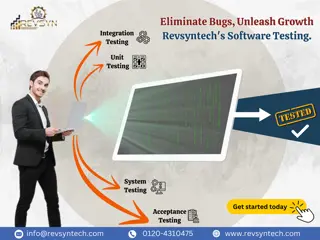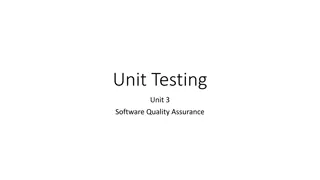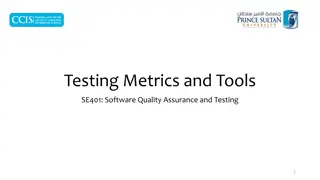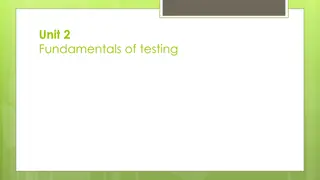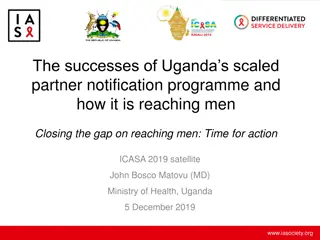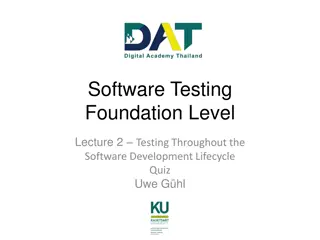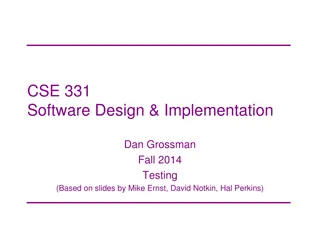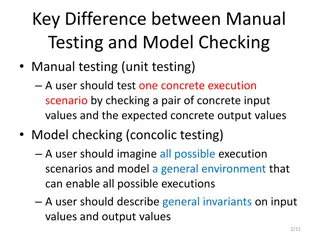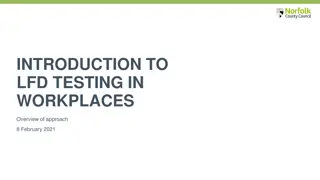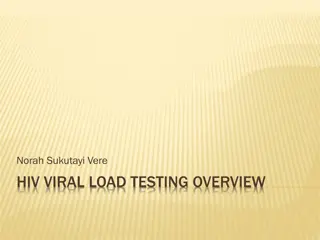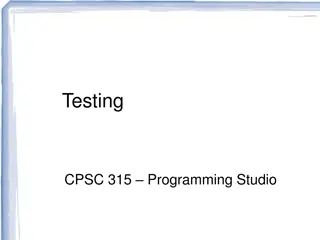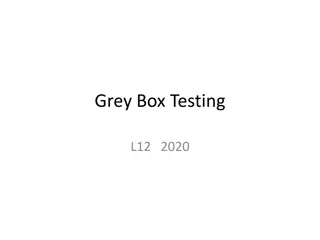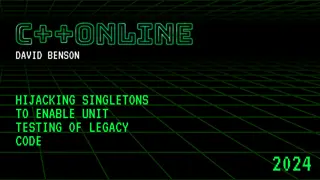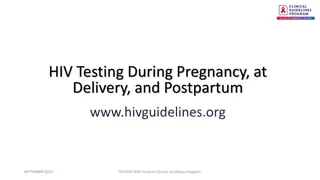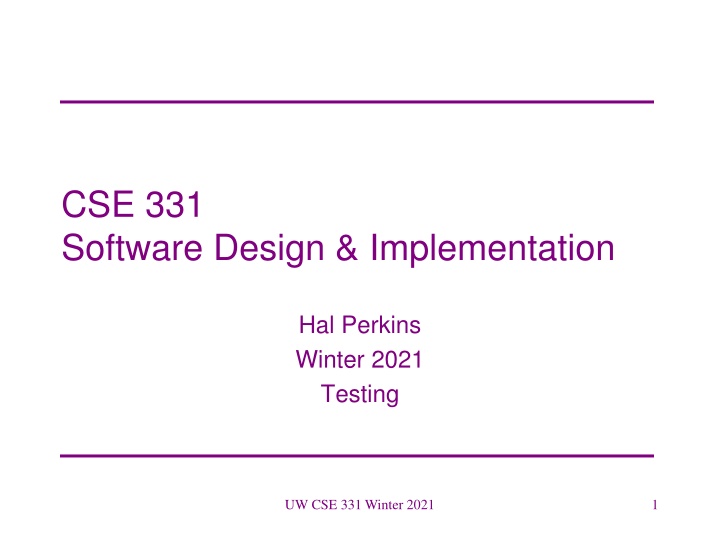
Software Design and Implementation: Testing, Grading, and Feedback
Explore the concepts of testing, grading, and feedback in software design and implementation for the course UW CSE 331 Winter 2021. Learn about project grading categories, basic grading scales, and additional project feedback criteria. Gain insights into holistic project grading, mechanics, and staff tests. Dive into the world of software design, classes, modules, and documentation to enhance your skills for future projects.
Download Presentation

Please find below an Image/Link to download the presentation.
The content on the website is provided AS IS for your information and personal use only. It may not be sold, licensed, or shared on other websites without obtaining consent from the author. If you encounter any issues during the download, it is possible that the publisher has removed the file from their server.
You are allowed to download the files provided on this website for personal or commercial use, subject to the condition that they are used lawfully. All files are the property of their respective owners.
The content on the website is provided AS IS for your information and personal use only. It may not be sold, licensed, or shared on other websites without obtaining consent from the author.
E N D
Presentation Transcript
CSE 331 Software Design & Implementation Hal Perkins Winter 2021 Testing UW CSE 331 Winter 2021 1
Administrivia HW4 due Thursday night Cannot change specs or tests AF/RI and loop invariants are your friends (really ) Next set of lectures after this are about design, classes & modules, and general style issues Leadup to hw5 which is the start of a long project Lots of related readings. Please dive in they will be very helpful on hw5 and later. UW CSE 331 Winter 2021 2
Project Grading Idea: provide meaningful feedback faster & avoid phony precision of complex, many-point grading rubrics Plan: project grades will be mostly holistic: 4 major categories, graded independently: Design (organization of classes/methods/etc.) Documentation (quality of specs; javadoc; etc.) Implementation/code quality (including RI/AF, other internal comments, naming, layout etc.) Testing (design & quality of tests and coverage) Several of these don t apply until hw5 or later UW CSE 331 Winter 2021 3
Basic grading scale For each major category, a single 0-3 score (much like a work or code review, not like intro programming) 3 = very good / superior, no major issues, easy / pleasant to read, probably a few fairly minor things to improve / fix up 2 = generally good but some non-trivial major, or too many minor, problems 1 = significant problems, needs major work 0 = not credible, cannot grade, etc. Expect scores to be a mix of 2 s and 3 s, with more 2 s earlier in the quarter and more 3 s as things improve with practice UW CSE 331 Winter 2021 4
Additional project feedback Most projects have these other scores: Staff tests automated tests run on tagged hwn-final versions of code. Max score varies depending on assignment but exact max doesn t matter scores are normalized when computing course grades Answers written answers to questions again, exact max can vary but scores are normalized Mechanics 0-3 score for whether correct files were pushed and tagged properly in repos, code compiles, javadoc generates, staff test scripts run even if some tests fail, etc. Should always be 3. If not, may seriously affect other scores. All scores kept as separate info in gradebook and combined at end of quarter to get an overall assessment UW CSE 331 Winter 2021 5
Administrivia (added Wed.) HW4 due tomorrow night please check your work when you think you re done (and rereading the specs at the end is a good idea too) HW5 posted by late today; HW6 writeup by early next week HW5: design/implement/test a Graph ADT 2 parts: design & write tests (1 week); implement (2ndweek) More in section this week (don t miss) Do initial design yourself (for sure have a first design by end of this weekend) then discuss ideas & tradeoffs with others (use whiteboards, etc.) HW6: social network. Might provide some more insight for what the graph ADT created in hw5 needs to support. UW CSE 331 Winter 2021 6
Outline Testing principles and strategies Purpose of testing Kinds of testing Heuristics for good test suites Black-box testing Clear-box testing and coverage metrics Regression testing UW CSE 331 Winter 2021 7
Non-outline Modern development ecosystems have much built-in support for testing Unit-testing frameworks like JUnit Regression-testing frameworks connected to builds and version control Continuous testing No tool details covered here See homework, section, internships, UW CSE 331 Winter 2021 8
How do we ensure correctness? Best practice: use three techniques 1. Tools e.g., type checking, @Override, libraries, etc. 2. Inspection think through your code carefully have another person review your code 3. Testing usually >50% of the work in building software Each removes ~2/3 of bugs. Together >97% UW CSE 331 Winter 2021 14
What can you learn from testing? Program testing can be used to show the presence of bugs, but never to show their absence! Edsgar Dijkstra Notes on Structured Programming, 1970 Testing is essential but it is insufficient by itself Only reasoning can prove there are no bugs. Yet... UW CSE 331 Winter 2021 15
How do we ensure correctness? Beware of bugs in the above code; I have only proved it correct, not tried it. -Donald Knuth, 1977 Trying it is a surprisingly useful way to find mistakes! No single activity or approach can guarantee correctness We need tools and inspection and testing to ensure correctness UW CSE 331 Winter 2021 16
Why you will care about testing In all likelihood, you will be expected to test your own code Industry-wide trend toward developers doing more testing 20 years ago we had large test teams now, test teams are small to nonexistent Reasons for this change: 1. easy to update products after shipping (users are testers) 2. often lowered quality expectations (startups, games) some larger companies want to be more like startups This has positive and negative effects UW CSE 331 Winter 2021 17
Its hard to test your own code Your psychology is fighting against you: confirmation bias tendency to avoid evidence that you re wrong operant conditioning programmers get cookies when the code works testers get cookies when the code breaks You can avoid some effects of confirmation bias by writing most of your tests before the code Not much you can do about operant conditioning UW CSE 331 Winter 2021 18
An approach to testing Validation = reasoning + testing Make sure module does what it is specified to do Uncover problems, increase confidence Two rules: 1. Do it early and often Catch bugs quickly, before they have a chance to hide Automate the process wherever feasible 2. Be systematic Have a strategy, and test everything eventually If you thrash about randomly, the bugs will hide in the corner until you're gone UW CSE 331 Winter 2021 19
Kinds of testing Testing is so important the field has terminology for different kinds of tests Won t discuss all possible kinds and terms Here are three orthogonal dimensions [so 8 varieties total]: Unit testing versus system/integration testing One module s functionality versus pieces fitting together Black-box testing versus clear-box testing Did you look at the code before writing the test? Specification testing versus implementation testing Test only behavior guaranteed by specification or other behavior expected for the implementation UW CSE 331 Winter 2021 20
Unit testing and system testing A unit test focuses on one method, class, interface, or module Test a single unit in isolation from all others If it fails, defect is localized Complications: if unit uses other libraries; if unit does mutations Typically done earlier in software life-cycle As soon as implementation exists Whenever it changes System testing = integration testing = end-to-end testing Run whole system, ensure pieces work together UW CSE 331 Winter 2021 21
Black-box and clear-box tests Black-box testing Tests designed using only information in the specification Clear-box (= white-box = glass-box) testing Implementation influences test design But both types of tests pass for any implementation. Clear-box may be checking for specific edge cases and have different choices of inputs based on additional knowledge of implementation (more later) UW CSE 331 Winter 2021 22
Specification vs implementation tests A specification test verifies behavior guaranteed by the specification (only) and any implementation of that spec should pass these tests An implementation test verifies behavior of a particular implementation Different implementations of a particular specification may have additional implementation-specific behaviors and properties that need to be checked Including testing specific interfaces, methods or other things that can differ among implementations of the same specification Orthogonal to black- vs clear-box choice UW CSE 331 Winter 2021 23
How is testing done? Write the test 1) Choose input data/configuration 2) Define the expected outcome Run the test 3) Run with input and record the outcome 4) Compare observed outcome to expected outcome UW CSE 331 Winter 2021 24
sqrt example // throws: IllegalArgumentException if x<0 // returns: approximation to square root of x public double sqrt(double x){ } What are some values or ranges of x that might be worth probing? x < 0 (exception thrown) x 0 (returns normally) around x = 0 (boundary condition) perfect squares (sqrt(x) an integer), non-perfect squares x<sqrt(x) and x>sqrt(x) that's x<1 and x>1 (and x=1) Specific tests: say x = -1, 0, 0.5, 1, 4 UW CSE 331 Winter 2021 25
Whats So Hard About Testing? Just try it and see if it works... // requires: 1 x,y,z 10000 // returns: computes some f(x,y,z) int proc1(int x, int y, int z){ } Exhaustive testing would require 1 trillion runs! Sounds totally impractical and this is a trivially small problem Key problem: choosing test suite (partitioning inputs) Small enough to finish in a useful amount of time Large enough to provide a useful amount of validation UW CSE 331 Winter 2021 26
Approach: Partition the Input Space Ideal test suite: Identify sets with same behavior Try one input from each set Two problems: 1. Notion of same behavior is subtle Naive approach: execution equivalence Better approach: revealing subdomains 2. Discovering the sets requires perfect knowledge If we had it, we wouldn t need to test Use heuristics to approximate cheaply UW CSE 331 Winter 2021 27
Naive Approach: Execution Equivalence // returns: x < 0 => returns x // otherwise => returns x int abs(int x) { if (x < 0) return -x; else return x; } All x < 0 are execution equivalent: Program takes same sequence of steps for any x < 0 All x 0 are execution equivalent Suggests that {-3, 3}, for example, is a good test suite UW CSE 331 Winter 2021 28
Execution Equivalence Can Be Wrong // returns: x < 0 => returns x // otherwise => returns x int abs(int x) { if (x < -2) return -x; else return x; } Two execution behaviors: x < -2 and x >= -2 Three possible behaviors: x < -2 OK, x = -2 or x= -1 (BAD), x >= 0 OK {-3, 3} does not reveal the error! UW CSE 331 Winter 2021 29
Heuristic: Revealing Subdomains A subdomain is a subset of possible inputs A subdomain is revealing for error E if either: Every input in that subdomain triggers error E, or No input in that subdomain triggers error E Need test only one input from a given subdomain If subdomains cover the entire input space, we are guaranteed to detect the error if it is present The trick is to guess these revealing subdomains make educated guesses about where the bugs might be then pick one example to test from each subdomain UW CSE 331 Winter 2021 30
Example For buggy abs, what are revealing subdomains? // returns: x < 0 => returns x // otherwise => returns x int abs(int x) { if (x < -2) return -x; else return x; } Example sets of subdomains: Which is best? {-2} {-1} {0} {1} { , -4, -3} {-2, -1} {0, 1, } { ,-6, -5, -4} {-3, -2, -1} {0, 1, 2, } Why not: UW CSE 331 Winter 2021 31
Heuristics for Designing Test Suites A good heuristic gives: Few subdomains For all errors in some class of errors E: high probability that some subdomain is revealing for E (i.e., triggers E) Different heuristics target different classes of errors In practice, combine multiple heuristics Really a way to think about and communicate your test choices UW CSE 331 Winter 2021 32
Heuristic: Black-Box Testing Explore alternate cases in the specification Procedure is a black box: interface visible, internals hidden, but you can use the spec to figure out things to test Example // returns: a > b => returns a // a < b => returns b // a = b => returns a int max(int a, int b) { } 3 cases lead to 3 tests (4, 3) => 4 (i.e. any input in the subdomain a > b) (3, 4) => 4 (i.e. any input in the subdomain a < b) (3, 3) => 3 (i.e. any input in the subdomain a = b) UW CSE 331 Winter 2021 33
Black Box Testing: Advantages Process is not influenced by component being tested Assumptions embodied in code not propagated to test data Avoids group-think of making the same mistake Robust with respect to changes in implementation Test data need not be changed when code is changed Allows for independent testing (less common nowadays) Testers need not be familiar with code Tests can be developed before the code Very helpful, especially if you are also the implementor UW CSE 331 Winter 2021 34
More Complex Example Write tests based on cases in the specification // returns: the smallest i such that // a[i] == value // throws: Missing if value is not in a int find(int[] a, int value) throws Missing Two obvious tests: ( [4, 5, 6], 5 ) => 1 ( [4, 5, 6], 7 ) => throw Missing Have we captured all the cases? ( ( ) ) = = Must hunt for multiple cases Including scrutiny of effects and modifies UW CSE 331 Winter 2021 35
Heuristic: Boundary Testing & Special Cases Create tests at the edges of subdomains Why? Off-by-one bugs Empty cases (0 elements, null, ) Overflow errors in arithmetic Object aliasing Small subdomains at the edges of the main subdomains have a high probability of revealing many common errors Also, you might have misdrawn the boundaries UW CSE 331 Winter 2021 36
Boundary Testing To define the boundary, need a notion of adjacent inputs One approach: Identify basic operations on input values Two values are adjacent if one basic operation apart Point is on a boundary if either: There exists an adjacent point in a different subdomain Some basic operation cannot be applied to the point Example: list of integers Basic operations: create, append, remove Adjacent points: <[2,3],[2,3,3]>, <[2,3],[2]> Boundary point: [ ] (can t apply remove) UW CSE 331 Winter 2021 37
Other Boundary Cases Arithmetic Smallest/largest values Zero Objects null Circular list Same object passed as multiple arguments (aliasing) UW CSE 331 Winter 2021 38
Boundary Cases: Arithmetic Overflow // returns: |x| public int abs(int x) { } What are some values or ranges of x that might be worth probing? x < 0 (flips sign) or x 0 (returns unchanged) Around x = 0 (boundary condition) Specific tests: say x = -1, 0, 1 How about int x = Integer.MIN_VALUE; // x=-2147483648 System.out.println(x<0); // true System.out.println(Math.abs(x)<0); // also true! From Javadoc for Math.abs: Note that if the argument is equal to the value of Integer.MIN_VALUE, the most negative representable int value, the result is that same value, which is negative UW CSE 331 Winter 2021 39
Boundary Cases: Duplicates & Aliases // modifies: src, dest // effects: removes all elements of src and // appends them in reverse order to // the end of dest <E> void appendList(List<E> src, List<E> dest) { while (src.size()>0) { E elt = src.remove(src.size()-1); dest.add(elt); } } What happens if src and dest refer to the same object? This is aliasing It s easy to forget! Watch out for shared references in inputs UW CSE 331 Winter 2021 40
Heuristic: Clear (glass, white)-box testing Focus: features not described by specification Control-flow details Performance optimizations Alternate algorithms for different cases Common goal: Ensure test suite covers (executes) all of the program Measure quality of test suite with % coverage Assumption implicit in goal: High coverage good test suite most mistakes discovered UW CSE 331 Winter 2021 41
Clear-box Testing Example There are some subdomains that are not evident from the specification, so black-box testing might not catch: boolean[] primeTable = new boolean[CACHE_SIZE]; boolean isPrime(int x) { if (x > CACHE_SIZE) { for (int i=2; i < x/2; i++) { if (x%i==0) return false; } return true; } else { return primeTable[x]; } } UW CSE 331 Winter 2021 42
Clear-box Testing: [Dis]Advantages Finds an important class of boundaries Yields useful test cases Consider CACHE_SIZE in isPrime example Important tests CACHE_SIZE-1, CACHE_SIZE, CACHE_SIZE+1 If CACHE_SIZE is mutable, may need to test with different CACHE_SIZE values Disadvantage: Tests may have same bugs as implementation Buggy code tricks you into complacency once you look at it (confirmation bias) Another good reason to write the tests before the code UW CSE 331 Winter 2021 43
How many tests is enough? Common goal is to achieve high code coverage Ensure test suite covers (executes) all of the program Assess quality of test suite with % coverage Tools can measure this for you Assumption is implicit in the goal High coverage means most mistakes discovered Far from perfect, but widely used Low coverage definitely indicates problems UW CSE 331 Winter 2021 44
Code coverage: statement coverage int min(int a, int b) { int r = a; if (a <= b) { r = a; } return r; } Consider any test with a b (e.g., min(1,2)) Executes every instruction Misses the bug Statement coverage (% statements executed) is not enough UW CSE 331 Winter 2021 45
Code coverage: branch coverage int quadrant(int x, int y) { int ans; if(x >= 0) ans=1; else ans=2; if(y < 0) ans=4; return ans; } 2 1 3 4 Consider two-test suite: (2,-2) and (-2,2). Misses the bug. Branch coverage(all tests go both ways ) is not enough Here, path coverage is enough (there are 4 paths) UW CSE 331 Winter 2021 46
Code coverage: path coverage int num_pos(int[] a) { int ans = 0; for(int x : a) { if (x > 0) ans = 1; // should be ans += 1; } return ans; } Consider two-test suite: {0,0} and {1}. Misses the bug. Or consider one-test suite: {0,1,0}. Misses the bug. Branch coverage is not enough But here path coverage (% all possible control flow paths) is enough, but no bound on path-count UW CSE 331 Winter 2021 47
Code coverage: what is enough? int sum_three(int a, int b, int c) { return a+b; } Path coverage is not enough Consider test suites where c is always 0 Typically a moot point since full path coverage is unattainable for realistic programs But do not assume a tested path is correct Even though it is more likely correct than an untested path Another example: buggy abs method from earlier in lecture UW CSE 331 Winter 2021 48
Varieties of coverage Various coverage metrics (there are more): Statement coverage Branch coverage Loop coverage Condition/Decision coverage Path coverage increasing number of test cases required (generally) Limitations of coverage: 1. 100% coverage is not always a reasonable target 100% may be unattainable (dead code) High cost to approach the limit 2. Code is not necessarily correct even if executed (see buggy abs above) 3. Coverage is just a heuristic We really want the revealing subdomains UW CSE 331 Winter 2021 49
Pragmatics: How Many/What Tests? Ideal: each test checks one specific thing (method, ) And checks only one specific behavior/aspect Failure points to responsible component Reality: can t always test in complete isolation Example: need to use observer(s) to see if creator, mutator, or producer yields correct result(s) And if constructor test fails, defect could be in observer or creator Reality: try to structure test suites so each test checks one new thing and has minimal dependence on others Failure more likely to point to a single component Reality: time is limited Goal is to increase confidence to level needed UW CSE 331 Winter 2021 50
Pragmatics: Regression Testing Whenever you find a bug Save the input that elicited that bug, plus the correct output Add these to the test suite Verify that the test suite fails Fix the bug Verify the fix Ensures that your fix solves the problem Don t add a test that succeeded to begin with! Helps to populate test suite with good tests Protects against regressions that reintroduce bug It happened at least once, and it might happen again UW CSE 331 Winter 2021 51
Rules of Testing First rule of testing: Do it early and do it often Best to catch bugs soon, before they have a chance to hide Automate the process if you can Regression testing will save time Second rule of testing: Be systematic If you randomly thrash, bugs will hide in the corner until later Writing tests is a good way to understand the spec Think about revealing domains and boundary cases If the spec is confusing, fix it and/or write more tests Spec can be buggy too Incorrect, incomplete, ambiguous, missing corner cases When you find a bug, write a test for it first and then fix it UW CSE 331 Winter 2021 52
Testing Tips Write tests both before and after you write the code (but only clear-box tests need to come after) Be systematic (revealing subdomains, ) Test your tests Put a bug in the code and be sure a test catches it Test code is different from regular code Changeability is less important; correctness is essential Do not write any test code that is not obviously correct Otherwise you need to test that code too! Unlike with regular code, it s ok to repeat code in tests when needed UW CSE 331 Winter 2021 53
Closing thoughts on testing Testing matters You need to convince others that the module works Catch problems earlier Bugs become obscure beyond the unit they occur in Don't confuse volume with quality of test data Can lose relevant cases in mass of irrelevant ones Look for revealing subdomains Choose test data to cover: Specification (black box testing) Code (clear (glass, white) box testing) Testing can't generally prove absence of bugs But it can greatly increase quality and confidence UW CSE 331 Winter 2021 54

